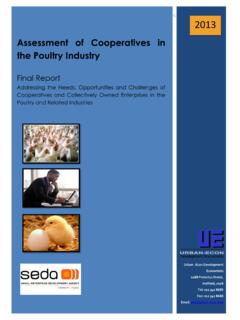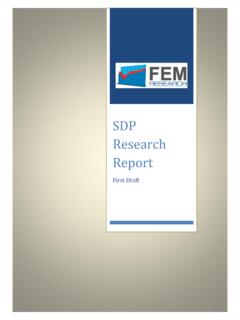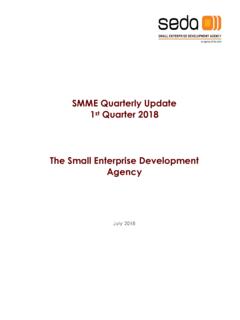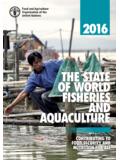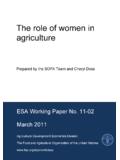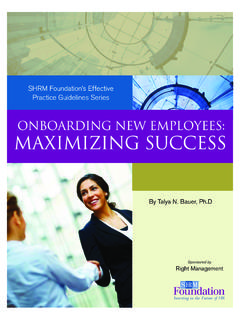Transcription of THE SMALL, MEDIUM AND MICRO ENTERPRISE …
1 THE SMALL, MEDIUM AND MICRO ENTERPRISE sector OF south africa Research Note 2016 | No 1 Commissioned by The Small ENTERPRISE Development Agency January 2016 BER Research Note 2016 | No 1 Please refer to the glossary on the BER s website for explanations of technical terms. Executive summary This report presents a broad statistical overview of the Small, MEDIUM and MICRO Enterprises (SMMEs) of south africa . The Department of Trade and Industry (DTI) published a comprehensive report on the SMME sector of south africa in 2008. Since then, the domestic, as well as global economy, changed significantly. The global financial crisis followed in 2008 and 2009, pulling the south African economy into recession.
2 Domestic economic policies changed, interest rates were reduced significantly, a new political administration came to power and much more. All these factors of change impacted on the SMME landscape in south africa , and we aim to identify those changes and evaluate the current situation. To do this, we used a two pronged approach. Firstly, we summarised some of the key issues from the latest literature on SMMEs. Secondly, we analyse and interpret the latest statistics on small businesses. In the literature study, we first set the scene by summarising the historical background of SMME policy in south africa . This is followed up by a list of findings and lessons. We found that SMMEs are challenged by access to finance and markets, poor infrastructure, labour laws, crime, skills shortages and inefficient bureaucracy.
3 In order to extract the latest statistical trends, we follow a similar methodology as the DTI to estimate the number of SMMEs in south africa over time. The statistical data should enable the reader and other researchers to take the next step and do an in depth analysis of specific topics on SMMEs. To present the statistics, we table and graph the two major types of economic indicators that describe SMMEs. Firstly, we used demographic and geographic indicators to identify where SMMEs operate, who owns them, how educated their owners are and in which economic sectors they function. Secondly, we used financial indicators to compare the size of SMEs according to economic sector , their tax, wages, interest and rents paid.
4 The following table summarises the key indicators: KEY INDICATORS 2015Q2 Number of SMMEs 2 251 821 Number of formal SMMEs 667 433 Number of informal SMMEs 1 497 860 SMME owners as % of total employment 14% % operating in trade & accommodation 43% % operating in community services 14% % operating in construction 13% % operating in fin. & business services 12% % contribution to GVA* 21% % black owned formal SMMEs 34% % operated by income group < R30k pa 7% Source: BER, StatsSA *GDP before taxes and subsidies We concluded that there is a significant distinction between the formal and informal sectors. The formal sector tends to be more educated, white, situated in Gauteng and the Western Cape, with a higher income generation.
5 However, most SMMEs are black owned and operate in the informal sector , especially in the more rural provinces. 2 BER Research Note 2016 | No 1 Contents Introduction .. 4 Context and background .. 5 Lessons from the literature .. 6 Challenges faced by SMMEs .. 7 Access to finance and credit .. 7 Poor infrastructure .. 7 Low levels of research and development (R&D) .. 8 Onerous labour laws .. 8 An inadequately educated workforce .. 9 Inefficient government bureaucracy .. 9 High levels of crime .. 10 Lack of access to markets .. 10 Risks faced by SMMEs .. 10 Methodology .. 11 Definition .. 11 The proxy .. 12 Other methodologies .. 14 The profile of SMMEs in south africa .. 15 Part I: Economic, geographic and demographic data.
6 15 Formal or informal sector .. 15 Provincial distribution .. 16 Economic sectors .. 18 Demographic distribution .. 21 Part II: Financial profile .. 27 Turnover .. 27 Company Tax .. 28 Net profit before tax .. 28 Employment costs .. 29 Rent paid .. 29 Interest paid .. 30 Vehicles .. 30 Total expenditure .. 31 Contribution to GDP .. 31 Conclusion .. 32 33 3 BER Research Note 2016 | No 1 List of tables Table 1: DTI s lower-boundaries on ENTERPRISE sizes (adjusted by StatsSA) .. 11 Table 2: Proxy for SMMEs (annual averages in millions) .. 13 Table 3: Number of SMMEs compared to the 13 Table 4: Type of SMME owners in 2015Q2 .. 15 Table 5: SMMEs by province .. 16 Table 6: SMMEs by economic sector .. 19 Table 7: SMMEs per population group.
7 21 Table 8: SMME owners per education group .. 24 Table 9: SMME owners by occupation group .. 25 List of figures Figure 1: south africa : type of 12 Figure 2: SMMEs by province: DTI & proxy vs. GDP .. 14 Figure 3: Type of SMME owners in 2015Q2 .. 16 Figure 4: SMMEs by province: 2008Q1 vs 2015Q2 .. 17 Figure 5: SMMEs by province and formal/informal sector (2015Q2) .. 17 Figure 6: GDP/SMME by province: 2008 vs 2013 .. 18 Figure 7: SMMEs by industry: number vs. turnover (2015) .. 20 Figure 8: SMMEs by industry: 2008Q1 vs 2015Q2 .. 20 Figure 9: SMMEs by industry and formal/informal sector (2015Q2) .. 21 Figure 10: SMMEs by Race: 2008Q1 vs 2015Q2 .. 22 Figure 11: SMME owners by race and formal/informal sector (2015Q2).
8 23 Figure 12: SMME owners by income group: 2010Q3 .. 23 Figure 13: SMME owners by education: 2008Q1 vs 2015Q2 .. 24 Figure 14: SMME owners by education and formal/informal sector (2015Q2) .. 25 Figure 15: SMME owners by occupation group: 2008Q1 vs 2015Q2 .. 26 Figure 16: SMME owners by occupation and formal/informal sector (2015Q2) .. 26 4 BER Research Note 2016 | No 1 Introduction In 2008, the DTI published a comprehensive report on the Small, MEDIUM and MICRO Enterprises (SMME) sector of south africa (The DTI, 2008). As economies evolve over time and adjust to new circumstances, so too the SMME landscape in south africa . This might be particularly true given the major economic events of the last eight years.
9 Some of these events include the global financial crisis of 2008 and 2009, and a new administration in government (President Zuma vs. former President Mbeki). Also a full cycle of interest rates (from a tightening to an accommodative cycle), and the peak of the commodity super cycle. With these changes in mind, it is reasonable to assume that the SMMEs in south africa have adapted themselves to the new circumstances. The aim of this report is to identify the current situation of SMMEs in south africa , and to compare this with their situation in 2008. From these time-comparisons some trends emerge. This research note starts off with a short overview of the current literature on SMMEs in south africa , with a focus on the DTI report.
10 Then we present the methodology used to derive a proxy for the number of SMMEs in the country. This section is followed by the relevant data, which is presented in tables and graphs according to two main topics. The first topic deals with demographic and geographic properties of SMMEs. It derives data from the Quarterly Labour Force Survey (QLFS), as published by Statistics south africa (StatsSA). Here we focus on the distribution of SMMEs by province, race, income groups and economic sectors. The second main topic focuses on the financial indicators of SMMEs. It is based on the Quarterly Financial Survey (QFS) of StatsSA, and the focus is on the aggregate income statement of companies1. Since we cover a wide spectrum of indicators on SMMEs, we mostly present only tables and graphs of the data, with limited comment and analysis.




